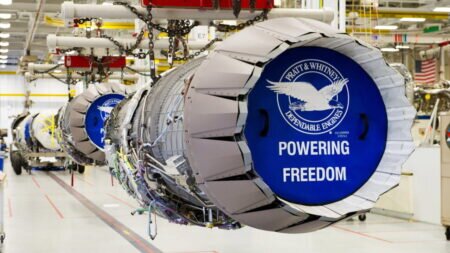For the first time in aerospace propulsion history, Pratt & Whitney has launched an innovative Usage Based Lifing (UBL) program for its F119 5th generation engine fleet, which is expected to save the U.S. Air Force $800+ million over the life of the program – while continuing to maximize readiness.
By digitally combining aircraft flight data with Pratt & Whitney’s state-of-the-art maintenance engineering algorithms, UBL allows the USAF to plan engine maintenance when it’s actually needed – maximizing both warfighting readiness and maintenance cost savings.
Two F119 engines power each F-22 Raptor in the U.S. Air Force’s fleet. When the F-22 reached Initial Operational Capability (IOC) and was declared combat-ready in 2005, the F119 turbofan became the first operational 5th generation fighter engine in history. One of the exceptional performance benefits the F119 gives the F-22 is supercruise, the ability to fly at supersonic speeds without afterburning, which provides the F-22 exceptional combat performance without compromising mission range. In addition to supercruise, the F119 combines stealth technologies, vectored thrust, and high thrust-to-weight performance to provide unprecedented maneuverability and survivability.
Along with performance, sustainment is a critical part of any engine program, as it’s crucial to maintain readiness at high levels and keep costs within budget. For decades, engine sustainment budgeting and planning was completed largely based on historical data and average mission usage metrics. Without full flight data, maintainers can only make assumptions about how the aircraft was flown and is going to fly and those assumptions are applied to every engine without the ability to tailor maintenance to an engine’s specific needs. As a result, engine maintenance might be performed earlier or later than necessary, leading to inefficiencies over the long run.
Incorporating Usage Based Lifing, however, allows the operator and Pratt & Whitney to collect large amounts of real-time data on engine components based on how it is actually being flown in the field versus an assumed mission mix. This constant flow of data is continuously re-analyzed and allows the customer to take advantage of the full life of the engine parts while reducing risk to the fleet. By capturing full flight data, UBL allows the operator to assess exactly how the aircraft was flown and apply the appropriate level of lifing capacity that was used – saving time and money while improving readiness.
Pratt & Whitney has partnered with the USAF over the last decade to utilize their combined engineering capabilities and logistics expertise to develop advanced tools sets and to capture the streaming data generated in today’s advanced platforms through the full flight of the aircraft/engine. The data is then transferred and processed through the Pratt & Whitney lifing system using advanced algorithms and logistics management tools. Those results are then passed to the maintainer in an actionable format. In order to reach this historic launch, a detailed validation plan was executed with the USAF. Pratt & Whitney captured and authenticated UBL data for two years to validate system functionality and integration points.
As part of the UBL launch, the entire F-22 fleet stationed at Nellis AFB has been converted to UBL tracking, vastly improving sustainment capabilities; and the F-22 units at Langley AFB are expected to start the conversion in March. In addition to saving money, successfully implementing this technology across the fleet will provide the USAF a model for applying the UBL process to other engine sustainment programs, which will further reduce costs, streamline maintenance, and improve readiness for the nation’s warfighters.









